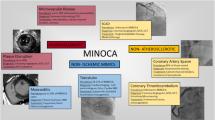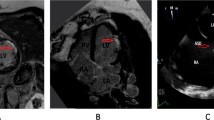Abstract
Myocardial infarction in the absence of obstructive coronary artery disease (MINOCA) represents 5–10% of patients presenting with acute myocardial infarction. MINOCA is a working diagnosis and coronary angiography, intravascular imaging and cardiac magnetic resonance imaging are important diagnostic tests. MINOCA is not a benign condition and can be associated with major adverse cardiac events. Therefore, diagnosis of the underlying etiology of MINOCA is imperative and impacts treatment and prognosis. The objective of this chapter is to provide a definition of MINOCA, examine the epidemiology, provide a diagnostic schema, review the pathophysiologic mechanisms of various causes of MINOCA and evaluate the prognosis of these patients. Several case examples are utilized to illustrate different causes and management of MINOCA.
Access this chapter
Tax calculation will be finalised at checkout
Purchases are for personal use only
Similar content being viewed by others
References
Gross H (1939) Myocardial infarction without significant lesions of coronary arteries. Arch Intern Med 64(2):249. https://doi.org/10.1001/archinte.1939.00190020035003
DeWood MA, Spores J, Notske R et al (1980) Prevalence of total coronary occlusion during the early hours of transmural myocardial infarction. N Engl J Med 303(16):897–902. https://doi.org/10.1056/NEJM198010163031601
Pasupathy S, Air T, Dreyer RP, Tavella R, Beltrame JF (2015) Systematic review of patients presenting with suspected myocardial infarction and nonobstructive coronary arteries. Circ 131(10):861–870. https://doi.org/10.1161/CIRCULATIONAHA.114.011201
Cheema AN, Yanagawa B, Verma S, Bagai A, Liu S (2021) Myocardial infarction with nonobstructive coronary artery disease (MINOCA): a review of pathophysiology and management. Curr Opin Cardiol 36(5):589–596. https://doi.org/10.1097/HCO.0000000000000886
Agewall S, Beltrame JF, Reynolds HR et al (2017) ESC working group position paper on myocardial infarction with non-obstructive coronary arteries. Eur Heart J 38(3):143–153. https://doi.org/10.1093/eurheartj/ehw149
Smilowitz NR, Mahajan AM, Roe MT et al (2017) Mortality of myocardial infarction by sex, age, and obstructive coronary artery disease status in the ACTION registry-GWTG (acute coronary treatment and intervention outcomes network registry-get with the guidelines). Circ Cardiovasc Qual Outcomes 10(12):1–8. https://doi.org/10.1161/CIRCOUTCOMES.116.003443
Planer D, Mehran R, Ohman EM et al (2014) Prognosis of patients with non-ST-segment-elevation myocardial infarction and nonobstructive coronary artery disease: propensity-matched analysis from the acute catheterization and urgent intervention triage strategy trial. Circ Cardiovasc Interv 7(3):285–293. https://doi.org/10.1161/CIRCINTERVENTIONS.113.000606
Singh T, Chapman AR, Dweck MR, Mills NL, Newby DE (2021) MINOCA: a heterogenous group of conditions associated with myocardial damage. Heart 107(18):1458–1464. https://doi.org/10.1136/heartjnl-2020-318269
Vojáček J, Janský P, Janota T (2013) Third universal definition of myocardial infarction. Cor Vasa 55(3):228–235. https://doi.org/10.1016/j.crvasa.2012.12.004
Thygesen K, Alpert JS, Jaffe AS et al (2018) Fourth universal definition of myocardial infarction (2018). J Am Coll Cardiol 72(18):2231–2264. https://doi.org/10.1016/j.jacc.2018.08.1038
Tamis-Holland JE, Jneid H, Reynolds HR et al (2019) Contemporary diagnosis and management of patients with myocardial infarction in the absence of obstructive coronary artery disease: a scientific statement from the American Heart Association. Circ 139(18):E891–E908. https://doi.org/10.1161/CIR.0000000000000670
Collet JP, Thiele H, Barbato E et al (2021) 2020 ESC Guidelines for the management of acute coronary syndromes in patients presenting without persistent ST-segment elevation. Eur Heart J 42(14):1289–1367. https://doi.org/10.1093/eurheartj/ehaa575
Pizzi C, Xhyheri B, Costa GM et al (2016) Nonobstructive versus obstructive coronary artery disease in acute coronary syndrome: a meta-analysis. J Am Heart Assoc 5(12):1–14. https://doi.org/10.1161/JAHA.116.004185
Safdar B, Spatz ES, Dreyer RP et al (2018) Presentation, clinical profile, and prognosis of young patients with myocardial infarction with nonobstructive coronary arteries (MINOCA): results from the VIRGO study. J Am Heart Assoc 7(13). https://doi.org/10.1161/JAHA.118.009174
Aumann S, Donner S, Fischer J (2019) High resolution imaging in microscopy and ophthalmology, pp 59–85. https://doi.org/10.1007/978-3-030-16638-0
Cruz Ferreira R, Pereira-Da-Silva T, Patrício L, Bezerra H, Costa M (2016) Coronary optical coherence tomography: a practical overview of current clinical applications. Rev Port Cardiol 35(2):105–112. https://doi.org/10.1016/j.repc.2015.09.016
Bangalore S, Bhatt DL (2013) Coronary intravascular ultrasound. Circulation 127(25):868–874. https://doi.org/10.1161/CIRCULATIONAHA.113.003534
Beltrame JF, Crea F, Kaski JC et al (2017) International standardization of diagnostic criteria for vasospastic angina. Eur Heart J 38(33):2565–2568. https://doi.org/10.1093/eurheartj/ehv351
Ong P, Camici PG, Beltrame JF et al (2018) International standardization of diagnostic criteria for microvascular angina. Int J Cardiol 250:16–20. https://doi.org/10.1016/j.ijcard.2017.08.068
Reynolds HR, Srichai MB, Iqbal SN et al (2011) Mechanisms of myocardial infarction in women without angiographically obstructive coronary artery disease. Circ 124(13):1414–1425. https://doi.org/10.1161/CIRCULATIONAHA.111.026542
Ouldzein H, Elbaz M, Roncalli J et al (2012) Plaque rupture and morphological characteristics of the culprit lesion in acute coronary syndromes without significant angiographic lesion: analysis by intravascular ultrasound. Ann Cardiol Angeiol (Paris) 61(1):20–26. https://doi.org/10.1016/j.ancard.2011.07.011
**ng L, Yamamoto E, Sugiyama T et al (2017) EROSION study (effective anti-thrombotic therapy without stenting: intravascular optical coherence tomography-based management in plaque erosion): a 1-year follow-up report. Circ Cardiovasc Interv 10(12):1–8. https://doi.org/10.1161/CIRCINTERVENTIONS.117.005860
Roffi M, Patrono C, Collet JP et al (2016) 2015 ESC Guidelines for the management of acute coronary syndromes in patients presenting without persistent ST-segment elevation: task force for the management of acute coronary syndromes in patients presenting without persistent ST-segment elevation of. Eur Heart J 37(3):267–315. https://doi.org/10.1093/eurheartj/ehv320
Hayes SN, Kim ESH, Saw J, Adlam D, Arslanian-Engoren C, Economy KE, Ganesh SK, Gulati R, Lindsay ME, Mieres JH, Naderi S, Shah S, Thaler DE, Tweet MS, Wood MJ (2018) American Heart Association Council on Peripheral Vascular Disease; Council on Clinical Cardiology; Council on Cardiovascular and Stroke Nursing; Council on Genomic and Precision Medicine; and Stroke Council. Spontaneous Coronary Artery Dissection: Current State of the Science: A Scientific Statement From the American Heart Association. Circ 137(19):e523–e557
Saw J, Aymong E, Mancini GBJ, Sedlak T, Starovoytov A, Ricci D (2014) Nonatherosclerotic coronary artery disease in young women. Can J Cardiol 30(7):814–819. https://doi.org/10.1016/j.cjca.2014.01.011
Saw J, Starovoytov A, Humphries K et al (2019) Canadian spontaneous coronary artery dissection cohort study: in-hospital and 30-day outcomes. Eur Heart J 40(15):1188–1197. https://doi.org/10.1093/eurheartj/ehz007
Imola F, Mallus M, Ramazzotti V et al (2010) Safety and feasibility of frequency domain optical coherence tomography to guide decision making in percutaneous coronary intervention. EuroIntervention 6(5):575–581. https://doi.org/10.4244/EIJV6I5A97
Tweet MS, Eleid MF, Best PJM et al (2014) Spontaneous coronary artery dissection: revascularization versus conservative therapy. Circ Cardiovasc Interv 7(6):777–786. https://doi.org/10.1161/CIRCINTERVENTIONS.114.001659
Cerrato E, Giacobbe F, Quadri G et al (2021) Antiplatelet therapy in patients with conservatively managed spontaneous coronary artery dissection from the multicentre DISCO registry. Eur Heart J 42(33):3161–3171. https://doi.org/10.1093/eurheartj/ehab372
Saw J, Aymong E, Sedlak T et al (2014) Spontaneous coronary artery dissection association with predisposing arteriopathies and precipitating stressors and cardiovascular outcomes. Circ Cardiovasc Interv 7(5):645–655. https://doi.org/10.1161/CIRCINTERVENTIONS.114.001760
Da Costa A, Isaaz K, Faure E, Mourot S, Cerisier A, Lamaud M (2001) Clinical characteristics, aetiological factors and long-term prognosis of myocardial infarction with an absolutely normal coronary angiogram: a 3-year follow-up study of 91 patients. Eur Heart J 22(16):1459–1465. https://doi.org/10.1053/euhj.2000.2553
Lanza GA, Sestito A, Sgueglia GA et al (2007) Current clinical features, diagnostic assessment and prognostic determinants of patients with variant angina. Int J Cardiol 118(1):41–47. https://doi.org/10.1016/j.ijcard.2006.06.016
Prinzmetal M, Kennamer R, Merliss R, Wada T, Bor N (1959) Angina pectoris I. A variant form of angina pectoris. Preliminary report. Am J Med 27(3):375–388. https://doi.org/10.1016/0002-9343(59)90003-8
Cox ID, Bøtker HE, Bagger JP, Sonne HS, Kristensen BO, Kaski JC (1999) Elevated endothelin concentrations are associated with reduced coronary vasomotor responses in patients with chest pain and normal coronary arteriograms. J Am Coll Cardiol 34(2):455–460. https://doi.org/10.1016/S0735-1097(99)00224-7
Okumura K, Yasue H, Matsuyama K et al (1996) Diffuse disorder of coronary artery vasomotility in patients with coronary spastic angina: hyperreactivity to the constrictor effects of acetylcholine and the dilator effects of nitroglycerin. J Am Coll Cardiol 27(1):45–52. https://doi.org/10.1016/0735-1097(95)00432-7
Lanza GA, Pedrotti P, Pasceri V, Lucente M, Crea F, Maseri A (1996) Autonomic changes associated with spontaneous coronary spasm in patients with variant angina. J Am Coll Cardiol 28(5):1249–1256. https://doi.org/10.1016/S0735-1097(96)00309-9
Takaoka K, Yoshimura M, Ogawa H et al (2000) Comparison of the risk factors for coronary artery spasm with those for organic stenosis in a Japanese population: role of cigarette smoking. Int J Cardiol 72(2):121–126. https://doi.org/10.1016/S0167-5273(99)00172-2
Yasue H, Takizawa A, Nagao M et al (1988) Long-term prognosis for patients with variant angina and influential factors. Circ 78(1):1–9. https://doi.org/10.1161/01.CIR.78.1.1
Piao ZH, Jeong MH, Li Y et al (2016) Benefit of statin therapy in patients with coronary spasm-induced acute myocardial infarction. J Cardiol 68(1):7–12. https://doi.org/10.1016/j.jjcc.2015.09.013
Beltrame JF, Crea F, Camici P (2009) Advances in coronary microvascular dysfunction. Hear Lung Circ 18(1):19–27. https://doi.org/10.1016/j.hlc.2008.11.002
Albadri A, Mavromatis K, Noel Bairey Merz C (2019) The role of coronary reactivity testing in women with no obstructive coronary artery disease. Curr Opin Cardiol 34(6):656–662. https://doi.org/10.1097/HCO.0000000000000682
Barbato E, Aarnoudse W, Aengevaeren WR et al (2004) Validation of coronary flow reserve measurements by thermodilution in clinical practice. Eur Heart J 25(3):219–223. https://doi.org/10.1016/j.ehj.2003.11.009
Mohri M, Koyanagi M, Egashira K et al (1998) Angina pectoris caused by coronary microvascular spasm. Lancet 351(9110):1165–1169. https://doi.org/10.1016/S0140-6736(97)07329-7
Luo C, Long M, Hu X et al (2014) Thermodilution-derived coronary microvascular resistance and flow reserve in patients with cardiac syndrome X. Circ Cardiovasc Interv 7(1):43–48. https://doi.org/10.1161/CIRCINTERVENTIONS.113.000953
Scalone G, Niccoli G, Crea F (2019) Editor’s choice-pathophysiology, diagnosis and management of MINOCA: an update. Eur Hear J Acute Cardiovasc Care 8(1):54–62. https://doi.org/10.1177/2048872618782414
Vidal-Perez R, Casas CAJ, Agra-Bermejo RM et al (2019) Myocardial infarction with non-obstructive coronary arteries: a comprehensive review and future research directions. World J Cardiol 11(12):305–315. https://doi.org/10.4330/wjc.v11.i12.305
Shibata T, Kawakami S, Noguchi T et al (2015) Prevalence, clinical features, and prognosis of acute myocardial infarction attributable to coronary artery embolism. Circulation 132(4):241–250. https://doi.org/10.1161/CIRCULATIONAHA.114.015134
Pasupathy S, Tavella R, Beltrame JF (2015) The what, when, who, why, how and where of myocardial infarction with non-obstructive coronary arteries (MINOCA). Circ J 80(1):11–16. https://doi.org/10.1253/circj.CJ-15-1096
Kang WY, Jeong MH, Ahn YK et al (2011) Are patients with angiographically near-normal coronary arteries who present as acute myocardial infarction actually safe? Int J Cardiol 146(2):207–212. https://doi.org/10.1016/j.ijcard.2009.07.001
Barr PR, Harrison W, Smyth D, Flynn C, Lee M, Kerr AJ (2018) Myocardial infarction without obstructive coronary artery disease is not a benign condition (ANZACS-QI 10). Hear Lung Circ 27(2):165–174. https://doi.org/10.1016/j.hlc.2017.02.023
Lindahl B, Baron T, Erlinge D et al (2017) Medical therapy for secondary prevention and long-term outcome in patients with myocardial infarction with nonobstructive coronary artery disease. Circ 135(16):1481–1489. https://doi.org/10.1161/CIRCULATIONAHA.116.026336
Author information
Authors and Affiliations
Corresponding author
Editor information
Editors and Affiliations
Rights and permissions
Copyright information
© 2023 The Author(s), under exclusive license to Springer Nature Switzerland AG
About this chapter
Cite this chapter
Albak, L., Gupta, A.K., Saeed, M., Liu, S. (2023). Myocardial Infarction with Non-obstructive Coronary Artery Disease: An Overview of Definition, Classification, Diagnostic Workup and Management. In: Kirshenbaum, L., Rabinovich-Nikitin, I. (eds) Biology of Women’s Heart Health. Advances in Biochemistry in Health and Disease, vol 26. Springer, Cham. https://doi.org/10.1007/978-3-031-39928-2_7
Download citation
DOI: https://doi.org/10.1007/978-3-031-39928-2_7
Published:
Publisher Name: Springer, Cham
Print ISBN: 978-3-031-39927-5
Online ISBN: 978-3-031-39928-2
eBook Packages: Biomedical and Life SciencesBiomedical and Life Sciences (R0)




